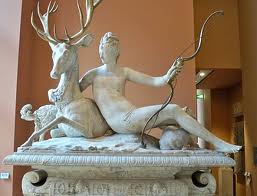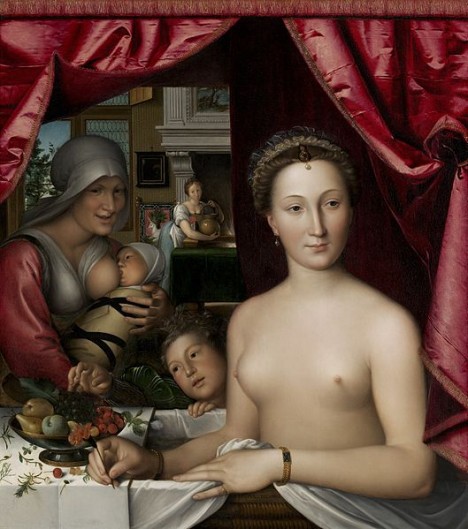Snippets of French history: Diane de Poitiers 1499-1566
Before I start on Diane de Poitiers I must answer your questions about Henri II and Catherine de Medici and their “genitalia” problems. We will never know for sure, but in those days – and till relatively recently – there were a lot of horrific misunderstandings. I think we can fairly safely assume that the young king did not realize quite what he was supposed to do. We know that Diane de Poitiers became his mistress a year after his marriage to Catherine de Medici, so we can be pretty sure that she taught him anything he needed to know. We can be equally sure that he already knew most of it via previous mistresses … yet with his wife he apparently did not perform and both he and his wife were confused as to why she didn’t get pregnant.
He probably thought that sex in the normal way with a mistress was one thing, but that sex with his lady wife, soon to be Queen no less, could not be like that. He probably ejaculated on to her tummy button or similar. Certainly tummy buttons were long considered related to sex and fertility. We also know that poor Catherine drank donkey urine and spread cow pats on her tummy in the belief that it would make her fertile … the era was riddled with this kind of thing.
 This statue by Jean Goujon of Diane de Poitiers is in the Louvre. She frequently posed nude. Here she represents the Roman goddess, Diana, goddess of the moon and of hunting.
This statue by Jean Goujon of Diane de Poitiers is in the Louvre. She frequently posed nude. Here she represents the Roman goddess, Diana, goddess of the moon and of hunting.
At first glance this may seem unlikely – but think about it – people were terrifyingly ignorant. I personally know a gentleman, now in his 70s, who did not know what to do on his wedding night (yes, he told me all about it!) and after a week of marriage went to see his doctor who explained it all to him. So that would have been in the 1960s. I also know a lady who died just 3 years ago, who thought her first baby was coming out of her tummy button – and she was the wife of a doctor! Actually, one of the pre-Raphaelites (1850-ish) was so shocked to discover on his wedding night that his bride had pubic hair (he thought only prostitutes did) that the marriage was never consumated – I think that was Ruskin – I’ll look it up. So, bref, this ignorance was rife in the days of Catherine de Medici.
Diane de Poitiers was aged 35 and the mother of two daughters when she first took 15 year-old Henri to her bed, so we can be sure that, in certain circumstances, the boy did know what to do. Just not with his wife.
Diane was a stunningly beautiful woman, a member of a long-standing noble family, and holder of many noble titles. She drank a small quantity of liquid gold every day, and maintained that this was the key to her long-lasting beauty. Scientists exhumed her body in 2009 and found large quantities of gold in her hair fibre – it probably killed her as she was 67 when she died, old enough for her era, but not particularly old. She was a keen sportswoman, an avid hunter, a very competent horsewoman, and this kept her physically strong and in good shape well in to her sixties.
 Diane in her bath by Clouet. It is not a painting I like, but it is interesting to look at: Diane sits in her bath tub, which was almost certainly made of marble but has a basket-work outer cage in order to keep it warm – like a tea cosy! The arrow-like quill in her right hand represents the huntress Diana, goddess, and the fruit on the table arrangement in front of her represents “plenty”. The other side of the bath is the wet-nurse feeding one of Diane’s daughters. The baby is swaddled as was the way. The other daughter (the age gap is wrong, actually) leans forward to take some fruit while the nurse smiles indulgently. In the background a maid carries a jug filled with hot water to top-up the bath, and just behind the maid we can see the fire where the water has been heated. The background is luxurious, with the ornate fireplace, the pictures and the large window reminiscent of Dutch windows. Out of the window is an oak tree, representing strength and durability, and this is reflected also in one of the pictures. I cannot see what the dark picture is, but the one below, which looks like a fireguard, shows a unicorn, symbol of grace and purity. I have been trying to make out the ring on Diane’s left hand, which could well be the king’s signet ring. At her ears and on her forehead are pearls, representing an expensive gift of pearls bestowed on her by the Pope. The whole thing is draped in red satin, representing royalty.
Diane in her bath by Clouet. It is not a painting I like, but it is interesting to look at: Diane sits in her bath tub, which was almost certainly made of marble but has a basket-work outer cage in order to keep it warm – like a tea cosy! The arrow-like quill in her right hand represents the huntress Diana, goddess, and the fruit on the table arrangement in front of her represents “plenty”. The other side of the bath is the wet-nurse feeding one of Diane’s daughters. The baby is swaddled as was the way. The other daughter (the age gap is wrong, actually) leans forward to take some fruit while the nurse smiles indulgently. In the background a maid carries a jug filled with hot water to top-up the bath, and just behind the maid we can see the fire where the water has been heated. The background is luxurious, with the ornate fireplace, the pictures and the large window reminiscent of Dutch windows. Out of the window is an oak tree, representing strength and durability, and this is reflected also in one of the pictures. I cannot see what the dark picture is, but the one below, which looks like a fireguard, shows a unicorn, symbol of grace and purity. I have been trying to make out the ring on Diane’s left hand, which could well be the king’s signet ring. At her ears and on her forehead are pearls, representing an expensive gift of pearls bestowed on her by the Pope. The whole thing is draped in red satin, representing royalty.
Diane lived at the royal Court of King Francois II, and quite possibly had an affair with him. The young price Henri, aged around 7, along with his brother, was kept hostage in Spain for four years during the Spanish conflicts, and when the princes were finally returned to France, Diane was appointed mentor and guradian of Henri. His own mother had died, and the boy was traumatised by his experiences in Spain. One can well imagine him turning to the older woman for comfort and mothering. Diane, on the other hand, was ambitious and exceptionally clever, and knew how to handle the boy.
Henri trusted Diane so much that she even wrote many of his state letters for him, and signed them “Henri-Diane”. She was so powerful at Court, and so influential, that courtiers needing the king’s attention or favours, approached Diane and not Queen Catherine. She was politically astute. She was especially knowlegeable in finance and law, and she spoke both Greek and Latin. Bright, beautiful, entertaining and loving, the king adored her and at the joust which killed him, he wore her colours and not that of his wife.
 Chateau d’Anet, where Diane de Poitiers lived out the rest of her life. The Chateau de Chenonceau (see yesterday’s item on Catherine de Medici) had also been given to her by Henri II, but Catherine took it back as soon as the king died.
Chateau d’Anet, where Diane de Poitiers lived out the rest of her life. The Chateau de Chenonceau (see yesterday’s item on Catherine de Medici) had also been given to her by Henri II, but Catherine took it back as soon as the king died.
With the death of the king, Catherine de Medici swung in to position and, as we saw in yesterday’s item, proved herself to be a stern and competent ruler on behalf of her young sons. The first thing she did, of course, was to banish Diane de Poitiers, who moved to her Chateau d’Anet (a gift from the late king) and lived out the rest of her life in luxurious obscurity.
If you enjoyed this item, please share!
Catherine Broughton is a novelist, a poet and an artist. Her books are on Amazon and Kindle, or can be ordered from most leading book stores and libraries. More about Catherine Broughton on http://turquoisemoon.co.uk
Click below for “Saying Nothing”, a novel set in Spain. “A love story totally different from most love stories” – the Daily Reader.
If Poitiers interests you:-





